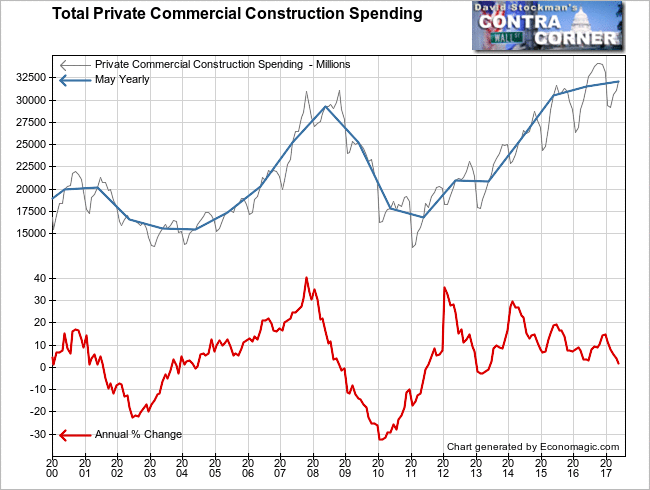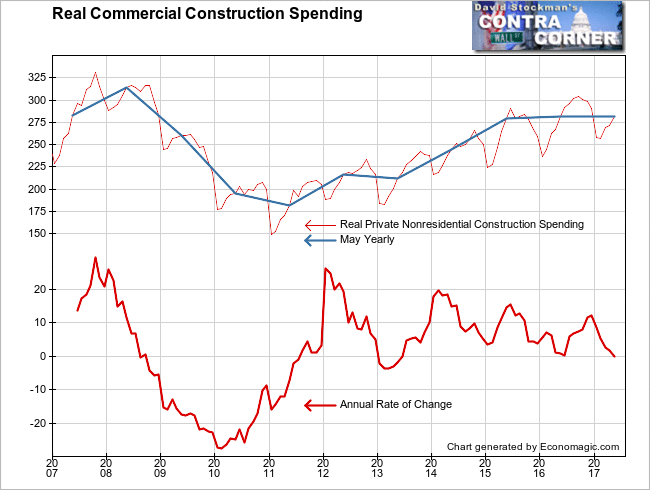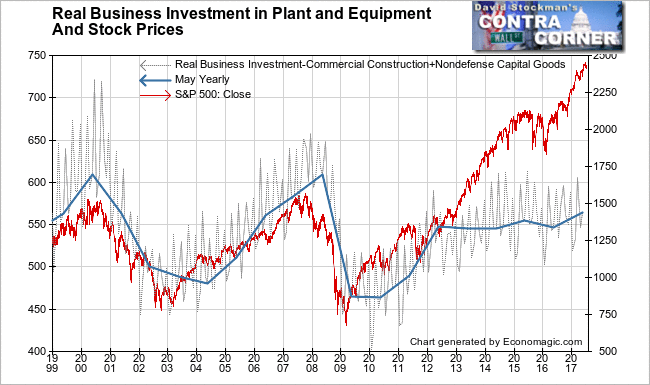Earlier this month the Census Bureau reported Private Construction Spending for May. It’s an important report primarily on the commercial side because it gives us a look into the all important commercial development sector. Aggregate that with Core Capital Goods Orders, and we get a great picture of the state of business investment and business confidence.
This isn’t a sentiment survey, it’s a measure of actual dollars spent. Money talks.
Looking at the nominal numbers before adjusting for inflation we see a strong recovery from 2001 to 2014. Since then, growth has slowed. Month to month growth in May was 3.2%, which is below the average May growth rate of 3.9% over the past 10 years. It’s also well below the May 2016 growth of 5.5%. The annual growth rate fell to just 1.6%. That is the slowest annual growth rate since 2013. Total spending has been slowing since 2014, in spite of record low construction lending rates. Demand is for commercial space is slowing not only because of slow growth in the economy, but because of technological change.

The picture darkens when we adjust for inflation. I used the PPI for office building construction as the deflator.
In the short run, there’s not much difference–a slightly below average gain for the month. But the index was down 0.2% from May of 2016. Furthermore the total volume of construction is 10.7% below the 2008 peak. While commercial construction is a lagging indicator at economic turning points, the fact that the total volume of construction is still below the levels of 10 years ago is a sign of the secular decline of the US economy.

It should come as no surprise that commercial construction is in long term decline. In the office sector an ever growing number of workers are telecommuting. Retail space is disappearing thanks to online retail. Reportedly, industrial space demand is growing. Booming industrial space demand is not unusual in the end stage of an economic expansion, as business sentiment becomes unduly optimistic.
The need for more office space as the economy expands is falling. Commercial real estate broker JLL reported vacancy rising to 14.8% in the second quarter from around 14.6%. But that doesn’t tell the whole story. They’re still building new buildings, but older buildings are losing occupancy and ultimately either being abandoned or converted to residential use.
According to commercial real estate information service REIS.com, commercial office space absorption fell by a whopping 65% in the first quarter. JLL reported that quarterly net space absorption was below the levels of the past 3 years. They expect vacancy to continue rising over the next 24 months, “as new buildings deliver and tenants upgrade to more efficient spaces.” That’s a nice way of saying that less space will be needed in the future as workers are replaced by automation, or work from home.
The collapse of retail is a well told story by now as Amazon.com destroys traditional retail. The demand for new retail space is collapsing. Here again, retail property vacancy rates do not tell the story because they don’t count abandoned properties. I could find no data on the rate of abandonment of retail space. Some of it is being converted to institutional or office use, which is equally problematic for the economy. When old commercial space is renovated and there’s a lack of new demand, it merely causes older, less functional space to no longer be economically viable. Tenants leave to occupy the newer, more efficient and attractive spaces. Obsolescence of older buildings often leads to more blight.
Commercial real estate brokers report that demand for industrial space is booming. Construction isn’t keeping pace with demand, according to JLL. I can’t confirm that with the construction data. A breakout of the value of industrial construction is not available in the Census Bureau report. It combines retail and warehouse space into a single category, which was down year to year. If industrial space development really is still running positive, then retail is even more negative.
Let’s not lose sight of the forest for the trees however. The fact is that the total volume of commercial construction has stalled. Ultra low construction loan and permanent mortgage rates have failed to stimulate growth over the past couple of years. It is possible that rising interest rates may stimulate a final spasm of overdevelopment as developers rush to bring projects on line before rates rise more. In the end, that would lead to an even bigger bust.
Commercial real estate cycles have been around forever. I have lived and worked through them as a professional in the field. This cycle will be no different.
Finally, we can combine the data on commercial construction with the data on nondefense capital goods orders for a measure of total business investment. Business people normally take their cues from the stock market. The renewed blowoff in stocks has triggered a renewal of growth in real total business investment, with a year to year rise of 3.3%.
It is striking that for 4 years prior to this, real investment went completely flat as stock prices bubbled higher. It’s not that there wasn’t capital available. The Fed made sure that there was plenty of money, and it made the cost of that capital zero. This chart shows clearly where all that printed money and free financing went. It went into stock buybacks and other forms of speculation and financial engineering, driving stock prices relentlessly higher, while real investment suffered. It was much more profitable to chase a quick buck in pushing stock prices higher, than to invest in real plant and equipment.

This bounce still leaves real investment more than 7% below the levels of 2000 and 2008.
Is the uptick in real investment now a good sign? Probably not as, ironically, real investment will now divert funds from speculative investment in financial assets, just as the Fed is about to become stingy with money.
The Fed is planning a real tightening of financial conditions when it begins to shrink its balance sheet this year. This will begin to suck cash out of the system and raise the cost of funding. The Fed will start small, but will increasingly turn the screws over the next year. Any further signs of strength in real investment will only encourage the Fed to continue tightening. That will be very bad news for stocks.
Therefore chasing this rally will come to no good end. It’s time to radically pare down your holdings, and look for short sales industries that will fare poorly under the paradigm of secular decline due to excess capacity and technological change.


